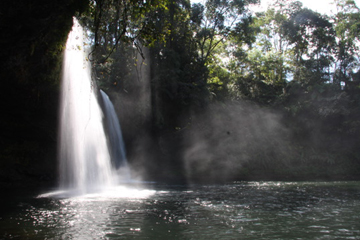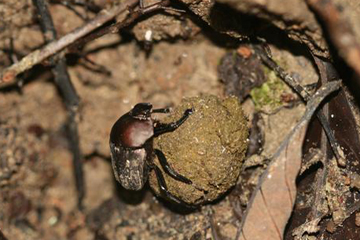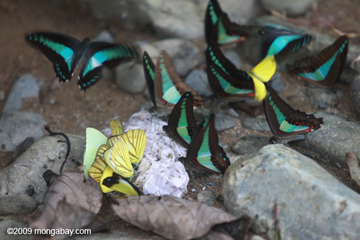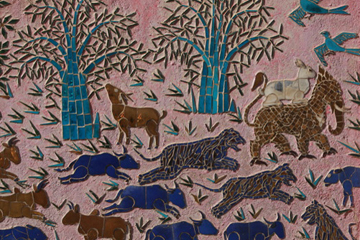What does Nature give us? A special Earth Day article
There is no question that Earth has been a giving planet. Everything humans have needed to survive, and thrive, was provided by the natural world around us: food, water, medicine, materials for shelter, and even natural cycles such as climate and nutrients. Scientists have come to term such gifts ‘ecosystem services’, however the recognition of such services goes back thousands of years, and perhaps even farther if one accepts the caves paintings at Lascaux as evidence. Yet we have so disconnected ourselves from the natural world that it is easy—and often convenient—to forget that nature remains as giving as ever, even as it vanishes bit-by-bit. The rise of technology and industry may have distanced us superficially from nature, but it has not changed our reliance on the natural world: most of what we use and consume on a daily basis remains the product of multitudes of interactions within nature, and many of those interactions are imperiled. Beyond such physical goods, the natural world provides less tangible, but just as important, gifts in terms of beauty, art, and spirituality.
Earth Day seems as good a day as any to remind ourselves what nature gives us free-of-charge. Here then is a selective sampling of nature’s importance to our lives:
 Tad lo waterfall in Laos. Photo by: Rhett A. Butler. Tad lo waterfall in Laos. Photo by: Rhett A. Butler. |
Fresh water: There is no physical substance humans require more than freshwater: without water we can only survive a few hellish days. While pollution and overuse has threatened many of the world’s drinking water sources, nature has an old-fashioned solution, at least, to pollution. Healthy freshwater ecosystems—watersheds, wetlands, and forests—naturally clean pollution and toxins from water. Soils, microorganisms, and plant roots all play a role in filtering and recycling out pollutants with a price far cheaper than building a water filtration plant. According to research, the more biodiverse the ecosystem, the faster and more efficiently water is purified.
Pollination:
Imagine trying to pollinate every apple blossom in an orchard: this is what nature does for us. Insects, birds, and even some mammals, pollinate the world’s plants, including much of human agriculture. Around 80% of the world’s plants require a different species to act as pollinator.
In agriculture, pollinators are required for everything from tomatoes to cocoa, and almonds to buckwheat, among hundreds of other crops. Globally, agricultural pollination has been estimated to be worth around $216 billion a year. However large such monetary estimates don’t include pollination for crops consumed by livestock, biofuels, ornamental flowers, or the massive importance of wild plant pollination.
Seed dispersal: Much like pollination, many of the world’s plants require other species to move their seeds from the parent plant to new sprouting ground. Seeds are dispersed by an incredibly wide-variety of players: birds, bats, rodents, megafauna like elephants and tapir, and even, researchers have recently discovered, fish. Seed dispersal is especially important for tropical forests where a majority of plants depend on animals to move.
Pest control:
A recent study found that bats save US agriculture billions of dollars a year simply by doing what they do naturally: eating insects, many of which are potentially harmful to US crops.
Almost all agricultural pests have natural enemies, along with bats, these include birds, spiders, parasitic wasps and flies, fungi, and viral diseases. The loss, or even decline, of such pest-eating predators can have massive impacts on agriculture and ecosystems.
 The world’s dung beetles have a dirty job, but someone has to do it: feeding exclusively on feces dung beetles play a big role in nutrient and soil recycling. This beetle was photographed in Malaysian Borneo. Photo by: Rhett A. Butler. The world’s dung beetles have a dirty job, but someone has to do it: feeding exclusively on feces dung beetles play a big role in nutrient and soil recycling. This beetle was photographed in Malaysian Borneo. Photo by: Rhett A. Butler. |
Soil health: The ground under our feet matters more than we often admit. Healthy fertile soil provides optimal homes for plants, while participating in a number of natural cycles: from recycling nutrients to purifying water. Although soil is renewable, it is also sensitive to overuse and degradation often due to industrial agriculture, pollution, and fertilizers. Natural vegetation and quality soil also mitigates excessive erosion, which can have dramatic impacts from loss of agricultural land to coastlines simply disappearing into the sea.
Medicine: Nature is our greatest medicine cabinet: to date it has provided humankind with a multitude of life-saving medicines from quinine to aspirin, and from morphine to numerous cancer and HIV-fighting drugs. There is no question that additionally important medications—perhaps even miracle cures—lie untapped in the world’s ecosystems. In fact, researchers estimate that less than 1% of the world’s known species have been fully examined for their medicinal value. However the ecosystems that have yielded some of the world’s most important and promising drugs—such as rainforests, peat swamps, and coral reefs—are also among the most endangered. Preserving ecosystems and species today may benefit, or even save, millions of lives tomorrow.
Fisheries: Humankind has turned to the rivers and seas for food for at least 40,000 years but probably even longer. Today, amid concern of a global fishery collapse, more than a billion people depend on fish as their primary source of protein, many of them among the global poor. Fisheries also provide livelihoods, both directly and indirectly, for around half a billion. Coral reefs, mangroves, and seagrass ecosystems provide nurseries for the world’s fisheries, while the open ocean is used for migrating routes and hunting.
Even with the direct importance of the world’s fisheries for food, stewardship has been lacking, allowing many populations to drop precipitously and still permitting ecologically destructive fishing. While the world’s fisheries are primarily threatened by overfishing, including bycatch, marine pollution is also a major problem.
 In the hugely imperiled tropical rainforests of Sumatra, diverse species of butterflies feed on ground nutrients. Photo by: Rhett A. Butler. In the hugely imperiled tropical rainforests of Sumatra, diverse species of butterflies feed on ground nutrients. Photo by: Rhett A. Butler. |
Biodiversity and wildlife abundance: The argument to save the world’s wildlife has often come from an aesthetic point of view. Many conservationists have fought to save species simply because they like a particular species. This is often why more popularly known animals—tigers, elephants, rhinos—receive far more attention than less popular (although just as endangered) wildlife—for example, the redbelly egg frog, the smokey bat, or the bastard quiver tree. But beyond making the world a less lonely, less boring, and less beautiful place—admirable reasons in themselves—many of the services provided by biodiversity are similar to those provided by all of nature. Biodiversity produces food, fibers, wood products; it cleans water, controls agricultural pests, pollinates and dispersers the world plants; and provides recreation, such as birdwatching, gardening, diving, and ecotourism.
In the discussion of biodiversity, however, bioabundance is often ignored. A loss in bioabundance means that species are not just important for their diversity, but for their numbers. While Asian elephants may not go extinct any time soon, their depletion in forests means that the ecosystems lose the elephants’ special ecological talents such as spreading seeds and engineering micro-habitats. The drop in salmon populations in the US has caused the entire freshwater ecosystem to receive less nutrients every year (researchers estimate a nutrient-drop of over 90 percent); this means less food for people, less salmon for predators, and a less rich river overall. Declining nutrients also makes it impossible for the salmon to rebound to optimal populations, creating a vicious circle of bio-decline.
Climate regulation:
The natural world helps regulate the Earth’s climate. Ecosystems such as rainforests, peatlands, and mangroves store significant amounts of carbon, while the ocean captures massive amounts of carbon through phytoplankton. While regulating greenhouse gases are imperative in the age of climate change, new research is showing that the world’s ecosystems may also play a role in weather. A recent study found that the Amazon rainforest acted as its own ‘bioreactor’, producing clouds and precipitation through the abundance of plant materials in the forest.
Economy: In the common tension viewed between the economy and the environment—e.g. do we clear-cut a forest or conserve it?—one fact is often neglected: the environment underpins the entire global economy. Without fertile soils, clean drinking water, healthy forests, and a stable climate, the world’s economy would face disaster. By imperiling our environment, we imperil the economy. According to research published in Science, the global worth of total ecosystem services could run between $40-60 trillion a year.
Health: Recent research has found what nature-lovers have long expected: spending time in a green space, such as a park, provides benefits for one’s mental and physical health. Exercising in a park, instead of inside a gym, has shown to provide mental health benefits as a greater sense of well-being. Walking for 20 minutes in a green space has been proven to help children with ADHD improve their concentration, even working as well, or better, than medication. People who live in more natural settings have better overall health, even when research has taken into account economic differences.
 Mosaic artwork of wildlife in Buddhist temple in Laos. Nature has inspired both art and religion around the world. Photo by: Rhett A. Butler. Mosaic artwork of wildlife in Buddhist temple in Laos. Nature has inspired both art and religion around the world. Photo by: Rhett A. Butler. |
Art: Imagine poetry without flowers, painting without landscapes, or film without scenery. Imagine if Shakespeare had no rose to compare Juliet to, or if William Blake had no Tyger to set alight. Imagine if Van Gogh lacked crows to paint or Durer a rhinoceros to cut. What would the Jungle Book be without Baloo or the Wind in the Willows without Mr. Badger? Imagine My Antonia without the red grass of the American prairie or Wuthering Heights without the bleak moors. How would The Lord of the Rings film series appear without the stunning mountain ranges of New Zealand, or Lawrence of Arabia without the desert of North Africa? There is no question that the natural world has provided global arts with some of its greatest subjects. What we lose in nature, we also lose in art.
Spiritual: While some of what nature provides us is measurable, most of what nature gives us is simply beyond measure. Economic measurements are useful; but as with most of what happens in the world, economics is simply incapable of capturing true worth. Science is also a useful measurement regarding the importance of nature, but once again cannot measure what nature means—practically and aesthetically—to each individual.
Perhaps the most difficult gift of nature’s to measure is its ingrained connection to human spirituality. In most of the world’s religions the natural world is rightly revered. In Christianity, Earthly paradise existed in a garden, while Noah, the original conservationist, is commanded by God to save every species. Buddhists believe all life—from the smallest fly to the blue whale—is sacred and worthy of compassion. For Hindus every bit of the natural world is infused with divinity. Muslims believe the natural world was created by Allah and only given to humans as gift to be held in trust. Indigenous cultures worldwide celebrate the natural world as their ‘mother’.
But one need not be religious to understand the importance of nature to the human spirit: one only need spend time alone in a shadowy forest, sit on a forgotten beach, touch the spine of a living frog, or watch the quarter moon swing behind mountain silhouettes.

No comments:
Post a Comment